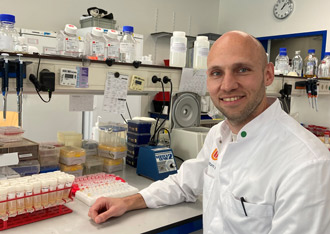Inhibiting HIV by Host Cell Targeting Strategies
Researchers identify two small antibodies that restrict HIV growth
By Jeffrey Laurence, M.D.

Research question
Antiretroviral therapy (ART) focuses on targeting components of the virus itself, including its reverse transcriptase, protease, and integrase enzymes. But ART has little effect on latent viral reservoirs, the main barrier to a cure.
An alternate host-targeting strategy uses antibodies to direct a person’s immune response toward normal host cell proteins essential to the virus’s lifecycle. As those proteins are highly conserved—unchanging and less likely to mutate—they reduce the risk of developing resistance and should be present on both actively and latently infected cells.
One such protein, tetraspanin C9, is critical to the process of HIV-infected cell-to-cell fusion. It is also incorporated into HIV particles to facilitate their release from infected cells. However, whether antibodies against C9 could restrict HIV growth remained untested.
Findings
The researchers immunized llamas with a portion of the C9 protein and identified two nanobodies—small antibodies with particular potency at binding to and inhibiting the activity of C9 when expressed on the surface of T cells and macrophages.
Nanobodies are 10 times smaller than traditional antibodies and are more stable. They are naturally produced by only a few animals—llamas, alpacas, camels, and sharks.

The nanobodies used in the study did not affect the early stages of HIV infection but could block the joining of HIV-infected cells, one mechanism by which HIV spreads, and suppress HIV growth.
Impact
The authors state that these nanobodies offer “a promising approach against HIV-1 replication … potentially augmenting existing antiretroviral treatments.” They also suggest they have other, broad benefits. “These nanobodies, with their diverse properties, show promise for applications in diagnostic and therapeutic contexts across various fields.” These include cancer and other severe viral and bacterial infections.
amfAR’s role
amfAR was a funder of this research. amfAR Krim Fellow Dr. Steven de Taeye and amfAR grantee Dr. Marit J. van Gils are co-authors of the study.
Original article
http://www.ncbi.nlm.nih.gov/pubmed/39391729
Dr. Laurence is amfAR’s senior scientific consultant.
Share This:
